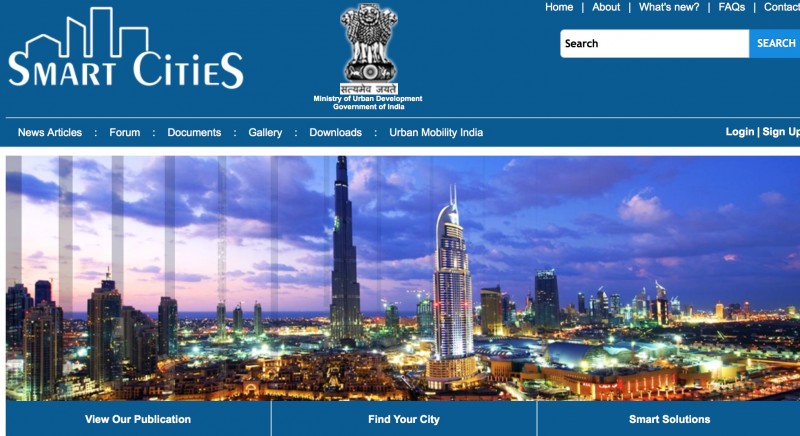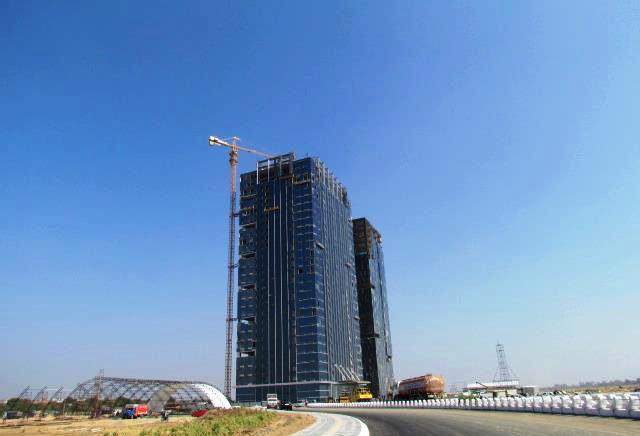India’s smart cities project, a vision of Prime Minister Narendra Modi, has been hailed in the country and domestic media alike for its sheer magnitude and ambition. The 100 smart cities are satellite towns of larger cities and will consist of modern infrastructure, which will be added to the existing mid-sized cities.
As an increasing number of Indian people move from villages to cities in search of opportunities, the government believes that this 70.6-billion-rupee plan [2] will ensure a high quality of life to people comparable with any developed European city.
But in a country where millions are struggling [3] to get by, the initiative has some observers wondering how people will be able to afford the expensive housing and living costs of smart cities. This has given rise to a debate: Is India’s smart cities project built to keep out the poor class?
India needs smart villages & not smart cities: #AnnaHazare [4] WATCH LIVE HERE : http://t.co/4La2nKbzs3 [5]
— ABP News (@abpnewstv) January 28, 2015 [6]
@MVENKAIAHNAIDU [7] @ #Chennai [8] #CII [9] #SmartCities [10] conference – “Gandhiji said: ‘Back to villages’..some take it as ‘turn your back to villages!’
— Preeti Singh (@TruthAbtNobody) January 29, 2015 [11]
One year on, there are still questions on what will constitute a smart city. According to a concept note [12] released by the urban development ministry, smart cities will be the cities which have (intelligent) physical, social, institutional and economic infrastructure, which ensure centrality of citizens in a sustainable environment.
The project has already started 12 kilometers from the city of Ahmedabad with the Gujarat International Finance Tec-City (GIFT) [13]. In the next five years, the place will boast of high rises with sparkling [14] glass facades, and the river Sabarmati flowing nearby will feature clean blue water.
The technology will be such that “human excrement will travel faster than most Indian trains,” Indian journalist Manu Joseph reported [16] in the New York Times. The buildings will be equipped with sophisticated surveillance, 24/7 electricity and clean water, and fast trains with automatic doors.
But the project is also facing multiple problems [17] and delays. The upcoming infrastructure in most parts of the country is coming at the expense of farming land.
Land acquisition in India is a very complicated process. The Modi government is looking to eliminate the requirement for the consent of landowners [18] for certain projects to make land acquisition quick. Memories of protests by farmers [19] against the construction of an expressway and India’s first Formula 1 track are still fresh, and the government's actions have contributed to a popular perception that they fight for private firms over farmers. The political opposition and its supporters have used the term ‘Suit Boot ki Sarkar [20]’ to reference Modi’s monogrammed suit and the government’s supposed preference for industrialization instead of agriculture and the common man.
#Modi [21]: “Land Bill is not a matter of life or death for me” But it is a matter of life & death for millions of poor farmers Modiji.
— Abdulla Madumoole (@AMadumoole) May 30, 2015 [22]
#Modi [21] & #CBN [23] together remind #Hitler [24] & #Tuglak [25] If you don't surrender land to CRDA under pooling we will acquire it thru #LandAcquisition [26]
— Make in Telangana (@gandhi_pv) May 3, 2015 [27]
In January 2015, comments from an economist at an interactive panel discussion on smart cities held in Chennai and Mumbai seemed to confirm criticism of the project. Journalist Shruti Ravindran tweeted various paragraphs [28] from the brochure ‘Smart Cities in India: Reality in the Making’ handed out to attendees.
“Smart cities” will, by definition, have to keep out the poor. From a conference in WTC Mumbai. pic.twitter.com/eViKxfcmMY [29] — Shruti Ravindran (@s_ravindran) January 29, 2015 [30]
@s_ravindran [31] the passage comes from this official brochure handed out in a smart city themed program held today. pic.twitter.com/eok3tfNCJU [32]
— Shruti Ravindran (@s_ravindran) enero 29, 2015 [33]
@s_ravindran [31] the economist Laveesh Bhandari, explains that it's “the natural way of things” to keep “some people out” pic.twitter.com/jAmMjdvQ1w [34]
— Shruti Ravindran (@s_ravindran) enero 29, 2015 [28]
The tweeted passages, which were taken from an essay within the brochure by Laveesh Bhandari, founder and chief economist at economic research firm Indicus Analytics, read:
When we build these smart cities, we will be faced with a massive surge of people who will desire to enter these cities. We will be forced to keep them out. This is the natural way of things, for if we do not keep them out they will override our ability to maintain such infrastructure. There are only two ways to keep people out of any space – prices and policing. In other words, the prices will automatically be higher in such cities – the notion that they will be low cost is flawed. Even if possible from a cost provision perspective, they cannot be low cost from a demand supply perspective.
Even with high prices, the conventional laws in India will not enable us to exclude millions of poor Indians from enjoying the privileges of such great infrastructure. Hence the police will need to physically exclude people from such cities, and they will need a different set of laws from those operating in the rest of India for them to be able to do so. Creating special enclaves is the only method of doing so. And therefore GIFT is a [special economic zone [35]] and so will each of these 100 smart cities have to be.
Safety and security are the outcomes of a city where the rule of law defines daily lives and where justice is the dominant notice of resolving disputes. But all disputes are not resolved through laws, policing or a judiciary; a well-functioning political mechanism is by far the best dispute resolution mechanism.
He later argued that the government will eventually:
[…] need to decide whether to continue with building such enclaves, or use these enclaves as an example, and expand such services across all of India's 8000 odd cities […] If it is the latter, it will need to move forward on a spate of urban reforms.
Read the essay in its entirety here [36].
Blogger Vidyut commented [37]in response:
So let me get this right. The government will be used to empty land to build smart cities in the name of developing the country. It will be called “inclusive development”. And the smart cities built on this land will be for the rich – by design. And we are talking of a hundred cities, displacing god knows how many people. The police of the land will be used “on the tax payer’s money” (as these hotshots like to call it) to keep the poor out of these cities using laws OTHER THAN INDIAN LAWS.
While “N”, commenting on her post [38], wrote:
On the face of it, it does seem cruel but nothing can make the development go faster and reach India’s poor than making our cities world class and attracting the talent and entrepreneurs which we are losing to emigration. With China reaching some 160 or so cities with more than a million population and the infrastructure in each city is just amazing, it can be seen how urbanisation is working there. Such fear mongering will lead us nowhere.
Critics see the smart cities project as something that will deepen the divide between the elite and the poor, and further take the ‘dreams of luxuries’ away from the public domain [39] and hand it to a few who can afford it.
@PMOIndia [40] India is made of 80%rural pop. Development of clusters is more important than smart cities to stop conversion of agri land
— sudershan shanker (@sudershansm) January 30, 2015 [41]
They fear that despite its promise of 24×7 electricity and high-rise buildings that will shine in daylight and glow in the dark, the smart cities project will cast dark shadows across the country. India needs something for its masses [42], but not everyone is convinced that smart cities are the answer.

